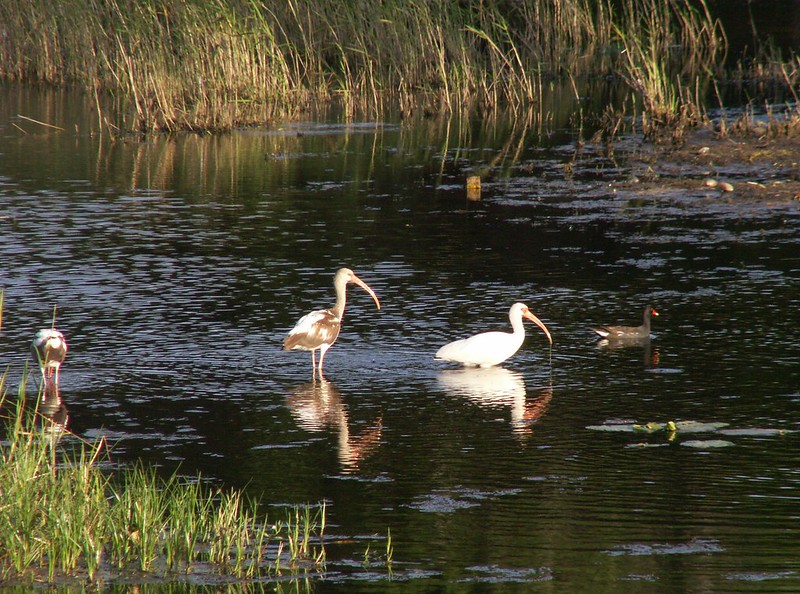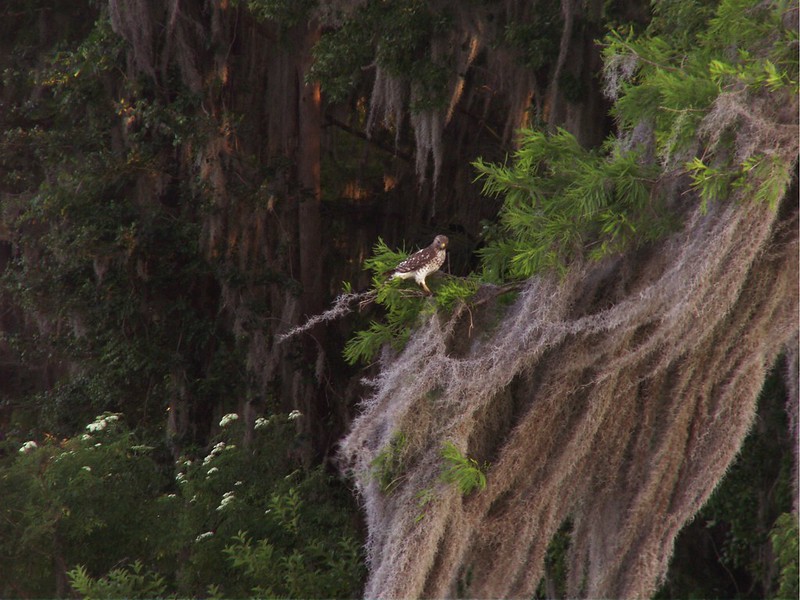Bird Convention! (Photo Heavy)
Yesterday Mary and I visited Liberty Park, where we've seen Sandhill Cranes. The cranes were nowhere to be seen this time, but we still got a show. (We also heard resident gator calls throughout.) Here, a Limpkin feeds to the left of a juvenile White Ibis:

Large
The Limpkin (Aramus guarauna, Family Aramidae) "is the only member of its taxonomic family," according to the Cornell Lab of Ornithology. "Although it resembles herons and ibises in general form, the Limpkin is generally considered to be more closely related to rails and cranes." Florida is the northern limit of its breeding range.
This species has a "screaming cry" that we heard while we were at the park. Cornell has a sample here.
The White Ibis (Eudocimus albus, Family Threskiornithidae) "is frequently seen on lawns looking for large insects as well as probing for prey along the shoreline," says Cornell. eNature adds, "Juvenile recalls adult, but has brown upper parts, streaked brown head and neck....Begins to acquire elements of adult's white plumage by first summer."
Pretty soon I spotted a Great Egret making its way among the foliage:

Large
Here it's in its neck-extended, hunting position:

Large
The Great Egret (Ardea alba, Family Ardeidae) "is found across much of the world, from southern Canada southward to Argentina, and in Europe, Africa, Asia, and Australia," according to Cornell. Its black legs distinguish it from the similar Great White Heron.
Here are two juvenile Ibises with an adult off to the right:

Large
Ibises are joined at far right by a Common Gallinule:

Large
The Common Gallinule (Gallinula galeata, Family Rallidae) is the "most widely distributed member of the rail family," according to Cornell. The species "inhabits marshes and ponds from Canada to Chile, from northern Europe to southern Africa, and across Asia to the Pacific. Vocal and boldly marked, the species can be quite conspicuous, sometimes using its long toes to walk atop floating vegetation."
The Egret flies over to join the other birds:

Large
Here it's joined by an adult Ibis in the left foreground, a juvenile in the right foreground, and a Limpkin up front to the right:

Large
Limpkin in the foliage:

Large
Here the Limpkin has found an apple snail (on which it feeds almost exclusively). A juvenile White Ibis feeds to the left of the Limpkin. Both are joined by three American Coots:

Large
The American Coots (Fulica americana, Family Rallidae) "often mix with ducks. But they’re closer relatives of the gangly Sandhill Crane and the nearly invisible rails than of Mallards or teal," according to Cornell. "Look for American Coots at ponds in city parks, in marshes, reservoirs, along the edges of lakes, and in roadside ditches, sewage treatment ponds, and saltwater inlets or saltmarshes."
Limpkin and Ibises:

Large
And there was Bird Drama! First, we spotted this juvenile Red-shouldered Hawk:

Large
The Red-Shouldered Hawk (Buteo lineatus, Family Accipitridae) includes the pale Florida form seen here. Its speckled chest indicates that it is immature. There are five subspecies, according to Cornell. This particular individual spent time flying from the tree to the water's edge and back up again.

Large
On the other side of the same tree, the hawk planted itself on the same branch as a Northern Mockingbird (left of the hawk, a little more than halfway back to the trunk):

Large
The mocker was not amused.
The Northern Mockingbirds (Mimus polyglottos, Family Mimidae) "sing almost endlessly, even sometimes at night, and they flagrantly harass birds that intrude on their territories, flying slowly around them or prancing toward them, legs extended, flaunting their bright white wing patches," according to Cornell.
We saw this move enacted repeatedly:

Large
Several shots in chronological order (best viewed large):

Large
By the time we left, a waxing crescent Moon was visible through the trees:

And Spanish moss was catching the sunset:

Elissa Malcohn's Deviations and Other Journeys Promote Your Page Too 
Vol. 1, Deviations: Covenant (2nd Ed.), Vol. 2, Deviations: Appetite, Vol. 3, Deviations: Destiny, Vol. 4, Deviations: Bloodlines, Vol. 5, Deviations: TelZodo, Vol. 6 and conclusion: Deviations: Second Covenant. Free downloads at the Deviations website (click here for alternate link), Smashwords, and Manybooks. 
Proud participant, Operation E-Book Drop (provides free e-books to personnel serving overseas. Logo from the imagination and graphic artistry of K.A. M'Lady & P.M. Dittman); Books For Soldiers (ships books and more to deployed military members of the U.S. armed forces); and Shadow Forest Authors (a fellowship of authors and supporters for charity, with a focus on literacy). 
This work is licensed under a Creative Commons Attribution-NonCommercial-ShareAlike 2.5 License.

Large
The Limpkin (Aramus guarauna, Family Aramidae) "is the only member of its taxonomic family," according to the Cornell Lab of Ornithology. "Although it resembles herons and ibises in general form, the Limpkin is generally considered to be more closely related to rails and cranes." Florida is the northern limit of its breeding range.
This species has a "screaming cry" that we heard while we were at the park. Cornell has a sample here.
The White Ibis (Eudocimus albus, Family Threskiornithidae) "is frequently seen on lawns looking for large insects as well as probing for prey along the shoreline," says Cornell. eNature adds, "Juvenile recalls adult, but has brown upper parts, streaked brown head and neck....Begins to acquire elements of adult's white plumage by first summer."
Pretty soon I spotted a Great Egret making its way among the foliage:

Large
Here it's in its neck-extended, hunting position:

Large
The Great Egret (Ardea alba, Family Ardeidae) "is found across much of the world, from southern Canada southward to Argentina, and in Europe, Africa, Asia, and Australia," according to Cornell. Its black legs distinguish it from the similar Great White Heron.
Here are two juvenile Ibises with an adult off to the right:

Large
Ibises are joined at far right by a Common Gallinule:

Large
The Common Gallinule (Gallinula galeata, Family Rallidae) is the "most widely distributed member of the rail family," according to Cornell. The species "inhabits marshes and ponds from Canada to Chile, from northern Europe to southern Africa, and across Asia to the Pacific. Vocal and boldly marked, the species can be quite conspicuous, sometimes using its long toes to walk atop floating vegetation."
The Egret flies over to join the other birds:

Large
Here it's joined by an adult Ibis in the left foreground, a juvenile in the right foreground, and a Limpkin up front to the right:

Large
Limpkin in the foliage:

Large
Here the Limpkin has found an apple snail (on which it feeds almost exclusively). A juvenile White Ibis feeds to the left of the Limpkin. Both are joined by three American Coots:

Large
The American Coots (Fulica americana, Family Rallidae) "often mix with ducks. But they’re closer relatives of the gangly Sandhill Crane and the nearly invisible rails than of Mallards or teal," according to Cornell. "Look for American Coots at ponds in city parks, in marshes, reservoirs, along the edges of lakes, and in roadside ditches, sewage treatment ponds, and saltwater inlets or saltmarshes."
Limpkin and Ibises:

Large
And there was Bird Drama! First, we spotted this juvenile Red-shouldered Hawk:

Large
The Red-Shouldered Hawk (Buteo lineatus, Family Accipitridae) includes the pale Florida form seen here. Its speckled chest indicates that it is immature. There are five subspecies, according to Cornell. This particular individual spent time flying from the tree to the water's edge and back up again.

Large
On the other side of the same tree, the hawk planted itself on the same branch as a Northern Mockingbird (left of the hawk, a little more than halfway back to the trunk):

Large
The mocker was not amused.
The Northern Mockingbirds (Mimus polyglottos, Family Mimidae) "sing almost endlessly, even sometimes at night, and they flagrantly harass birds that intrude on their territories, flying slowly around them or prancing toward them, legs extended, flaunting their bright white wing patches," according to Cornell.
We saw this move enacted repeatedly:

Large
Several shots in chronological order (best viewed large):

Large
By the time we left, a waxing crescent Moon was visible through the trees:

And Spanish moss was catching the sunset:













0 Comments:
Post a Comment
<< Home